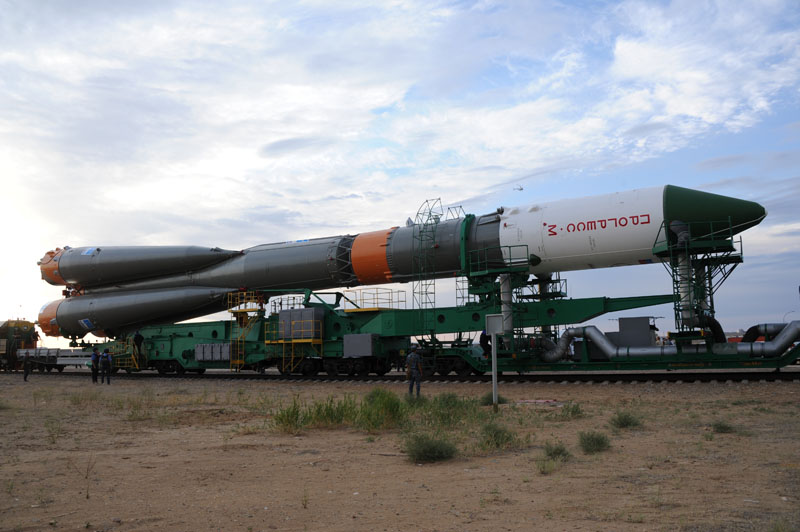Soyuz FG/Fregat – Launch Vehicle
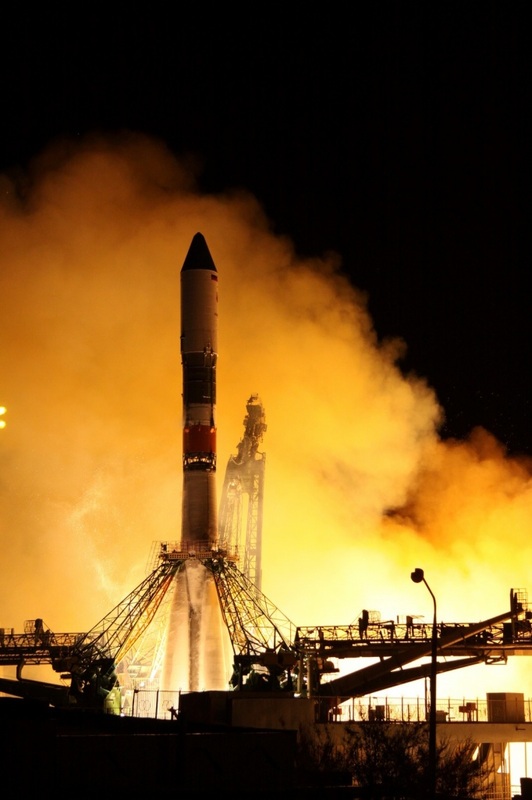
The Soyuz FG is a medium-lift launch vehicle qualified for manned launches and used to deliver Soyuz Spacecraft to Orbit for Missions to the International Space Station. The vehicle is a member of the Soyuz Rocket Family that has a history dating back to 1957.
Soyuz launchers have been derived from the R-7 missile that was developed during the Cold War making 28 launches between 1957 and 1961. There have been various different versions of the Soyuz Launcher; currently a number of different configuration is available to serve a variety of purposes. Soyuz FG was introduced in 2001 and is based on the Soyuz-U Launcher which has been modified to provide performance and safety improvements required for human space flight.
Soyuz FG is manufactured by TsSKB-Progress and operated by RKK Energia and Roscosmos. The vehicle launches from the Baikonur Cosmodrome. Most Launches were indeed manned space flights using the Russian Soyuz Spacecraft for missions to ISS, but the Soyuz FG launcher is also available for commercial and government flights to deliver payloads to a variety of Orbits by adding a Fregat Upper Stage to the Vehicle.
Soyuz FG is a three-stage rocket utilizing a core stage which Burns through the first and second stage portions of the flight. Stage one is comprised on the Core Stage and four strap-on boosters. Core Stage, Boosters and third stage all use Rocket Propellant 1 and Liquid Oxygen as propellants. To date, Soyuz FG made 46 flights, all of which were completed successfully. Other Versions of the Soyuz Rocket include the Soyuz-U for Progress Flights to ISS and government launches and the Soyuz 2 vehicle for commercial flights from both, Baikonur and the Guiana Space Center, French Guiana.
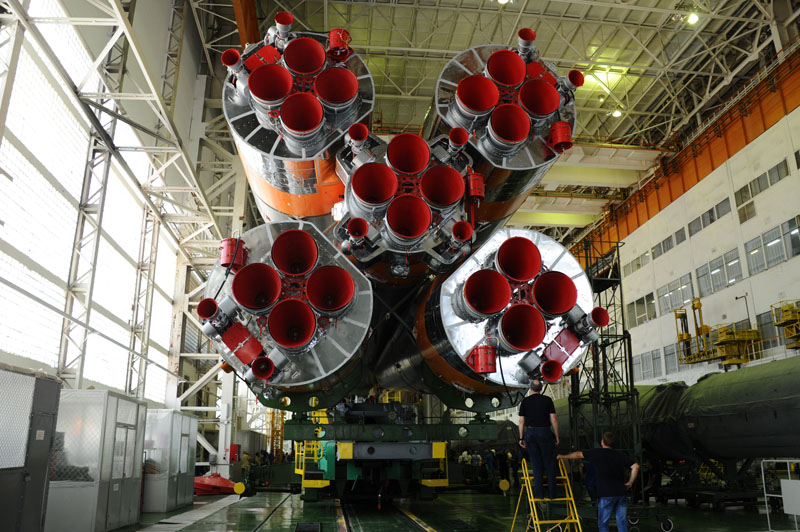
| Type | Soyuz FG |
| Manufacturer | TsSKB-Progress |
| Height | 49.5m |
| Diameter | 2.68m |
| Launch Mass | 305,000kg |
| Stages | Boosters + 2 Stages |
| Boosters | 4 |
| Mass to LEO | 7,100kg |
| Success Rate | 100% |
Soyuz FG Specifications
The Soyuz-FG Vehicle stands 49.5 meters tall and has a main diameter of 2.95 meters and a maximum diameter of 10.3 meters.
All stages of the vehicle use Rocket Propellant 1 (Rocket-Grade Kerosene) and Liquid Oxygen as propellants.
Liftoff mass is about 305,000 Kilograms. The FG version of the Soyuz can deliver payloads of up to 7,100 Kilograms to Low Earth Orbit. The Vehicle features a Launch Escape System to maintain high safety standards for manned space flight.
.
Boosters
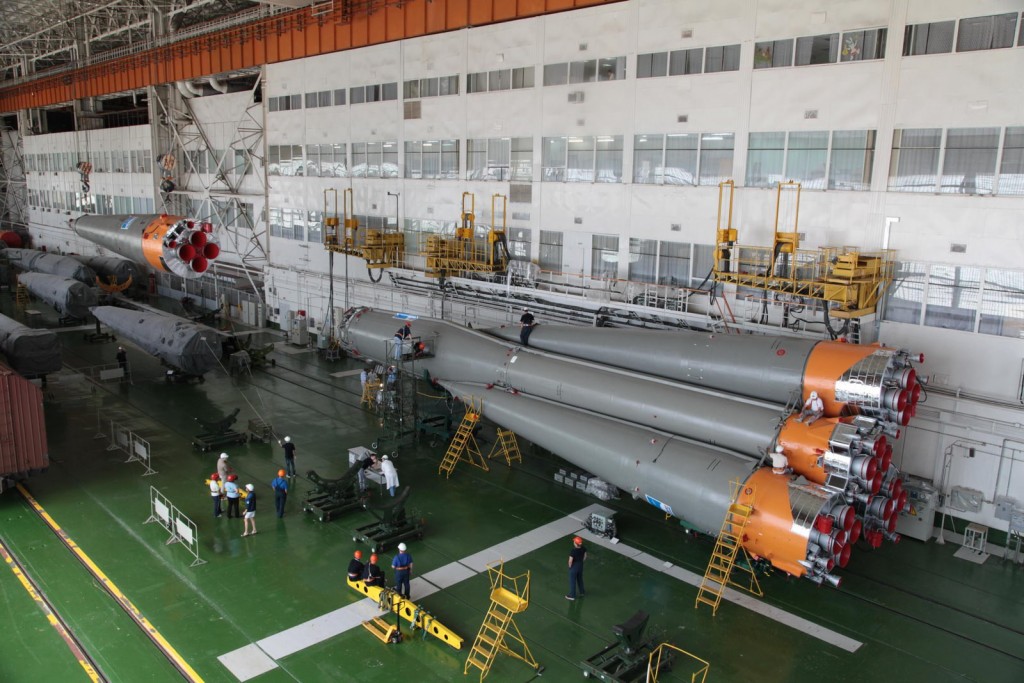
| Boosters | 4 |
| Diameter | 2.68m |
| Length | 19.6m |
| Empty Mass | 3,810kg |
| Fuel | Rocket Propellant 1 |
| Oxidizer | Liquid Oxygen |
| Fueled Mass | 43,410kg |
| Guidance | From 3rd Stage |
| Tank Pressurization | Nitrogen |
| Propulsion | 1 RD-107A |
| Propellant Feed | Turbopump |
| Comb. Chambers | 4 |
| Total Thrust SL | 838.5kN |
| Total Thrust Vac | 1,021kN |
| Engine Length | 2.58m |
| Engine Diameter | 1.85m |
| Engine Dry Weight | 1,090kg |
| Burn Time | 118s |
| Specific Impulse | 264s (SL) 310s (Vac) |
| Chamber Pressure | 60bar |
| Throttle Capability | Yes |
| Engine Start | Spark |
| Restart Capability | No |
| Ox to Fuel Ratio | 2.47 |
| Attitude Control | 2 Vernier Thrusters |
| Shutdown | Commanded Shutdown |
Soyuz FG is outfitted with four liquid fueled strap-on boosters providing extra lift during the initial phase of the flight.
All four boosters are ignited before liftoff to reach full thrust and are jettisoned once their fuel tanks are empty. The boosters are arranged around the central Core Stage and are tapered cylinders. The Oxidizer Tank is in the tapered portion of the booster while the fuel tank is inside the cylindrical portion. Each booster holds a total of 39,600 Kilograms of Propellants which are Liquid Oxygen and Rocket Propellant 1.
A Soyuz Booster is 19.6 meters in length and 2.68 meters in diameter. An RD-107A Engine is installed on each booster providing a thrust of 838.5 Kilonewtons at Liftoff. The engine utilizes a spark ignition system and can not be re-started. RD-107A features four combustion chambers that are fed by a Turbopump transferring 91 Kilograms of Kerosene and 226 Kilograms of Oxygen every second.
Several auxiliary pumps are used to keep the Propellant Tanks at flight pressure by feeding them with Nitrogen. Another pump delivers Hydrogen Peroxide to the main pump that is used to power it. A total of 1,190 kilograms of Hydrogen Peroxide and 280 Kilograms of liquid Nitrogen are stored inside spherical tanks and are expended during ascent for the aforementioned purposes.
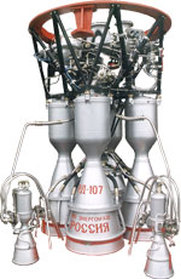
The Turbopump spins at over 8,000rpm at flight speed. The four nozzles of the RD-107 can not be gimbaled, but the engine is outfitted with two vernier jets that can be used for attitude control. Also, an aerofin is installed on the base of the booster and also contributes to attitude stability.
The engine has a dry weight of 1,090 Kilograms and is 2.58 meters in length and 1.85 meters in diameter. All boosters ignite about 20 seconds before launch to allow the Turbopumps to spin up to flight speed. Also, the engines are being monitored during that period to make sure performance is nominal.
The Boosters Burn for 118 seconds following liftoff before being separated from the launch vehicle and impacting downrange.
Photo: RSC Energia
Core Stage
| Diameter | 2.95m |
| Length | 27.8m |
| Empty Mass | 6,550kg |
| Fuel | Kerosene |
| Oxidizer | Liquid Oxygen |
| Fueled Mass | 99,500kg |
| Guidance | From 3rd Stage |
| Propulsion | 1 RD-108A |
| Engine Type | Gas Generator |
| Propellant Feed | Turbopump |
| Total Thrust SL | 792kN |
| Total Thrust Vac | 990kN |
| Engine Length | 2.87m |
| Engine Diameter | 1.95m |
| Engine Dry Weight | 1,075kg |
| Burn Time | 280s |
| Specific Impulse | 258s (SL) 321s (Vac) |
| Chamber Pressure | 54.43bar |
| Ox to Fuel Ratio | 2.39 |
| Throttle Capability | Yes |
| Engine Start | Spark |
| Restart Capability | No |
| Ox to Fuel Ratio | 2.47 |
| Attitude Control | 4 Vernier Thrusters |
| Shutdown | Commanded Shutdown |
The Core Stage of the Soyuz Vehicle acts as both, first and second stage. It is ignited prior to blastoff and continues to power the launcher after Booster Jettison as the second stage.
The Core Stage is 27.8 meters long and 2.95 meters in diameter. It is equipped with a large Oxidizer Tank and a Fuel Tank beneath it, both holding a total of 92,950 Kilograms of Propellants. Where the boosters interface with the core stage, a load carrying ring is installed to transfer loads from the boosters to the vehicle.
On top of the core stage is a Truss Segment that interfaces with the upper stage and includes stage separation mechanisms.
The core stage is powered by a RD-108A Engine which is similar to the Booster Main Engine. It also features four combustion chambers and the same pump design. the main Turbopump is also powered by Hydrogen Peroxide. 2,600 Kilograms are consumed during the burn of the stage. 520 Kilograms of liquid Nitrogen are used to keep the Propellant Tanks at flight pressure during the ascent.
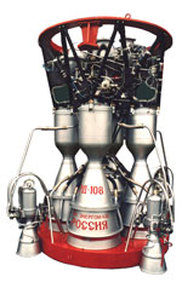
RD-108A provides 792 Kilonewtons of Thrust at Launch. Vacuum Thrust is 990 Kilonewtons. The Engine has a dry weight of 1,075 Kilograms and operates at a chamber pressure of 54.43 bar. Four Vernier Engines can be gimbaled to provide three-axis-attitude control during the ascent phase of the mission. The first stage is ignited 20 seconds before liftoff for performance monitoring.
The Stage burns for 290 seconds before separating from the third stage. The two stages are separated by igniting the third stage to push the core stage away from the stack. During second stage flight, the protective Payload Fairing and Launch Escape Tower are jettisoned to increase launcher performance.
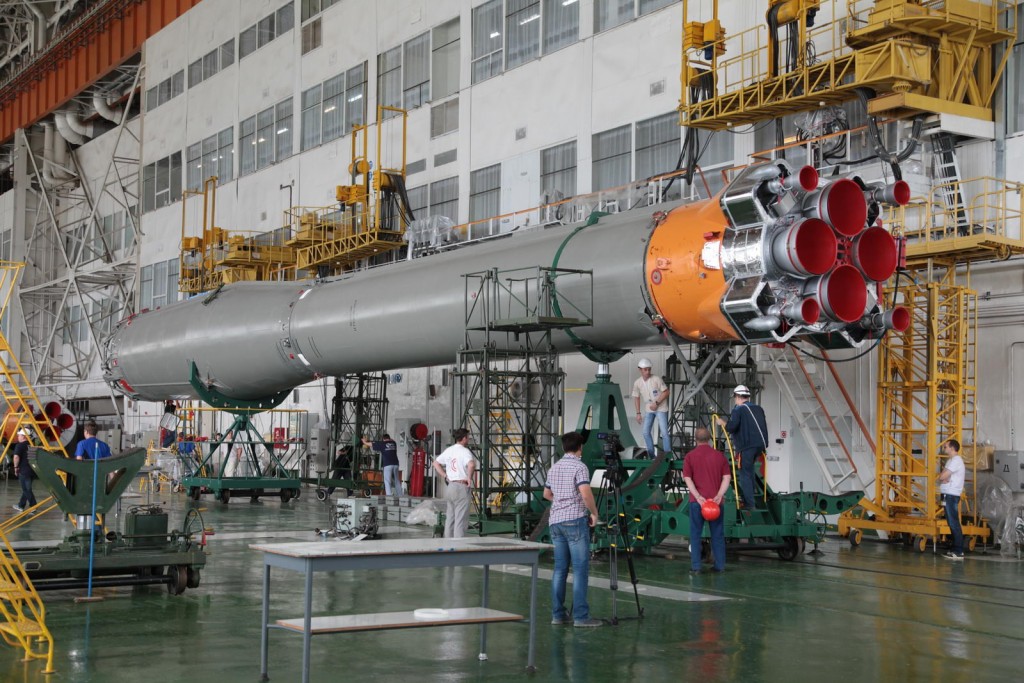
Block I Upper Stage
| Diameter | 2.66m |
| Length | 6.74m |
| Empty Mass | 2,410kg |
| Fuel | Rocket Propellant 1 |
| Oxidizer | Liquid Oxygen |
| Fueled Mass | 25,300kg |
| Tank Pressurization | Oxygen Gas; Combustion Products |
| Propulsion | 1 RD-0110 |
| Engine Type | Gas Generator |
| Propellant Feed | Turbopump |
| Comb. Chambers | 4 |
| Total Thrust Vac | 297.9kN |
| Engine Length | 1.58m |
| Engine Diameter | 2.24m |
| Engine Dry Weight | 408kg |
| Nozzle Ratio | 82.2 |
| Thrust-to-Weight | 74.5 |
| Burn Time | 230s |
| Specific Impulse | 326s (Vac) |
| Chamber Pressure | 68.2bar |
| Restart Capability | No |
| Ox to Fuel Ratio | 2.2 |
| Attitude Control | 4 Vernier Jets; Reaction Nozzle |
| Shutdown | Commanded Shutdown |
The third stage of the Soyuz FG Launcher is 6.74 meters in length and 2.66 meters in diameter. It also uses the conventional design with the Fuel Tank being placed on top of the Oxygen tank.
The Avionics of the Soyuz Launcher are also installed on the Upper Stage. They provide vehicle control, telemetry and navigation for the entire flight and issue all vehicle commands autonomously. The equipment is located in the area between the two propellant tanks. The third stage tanks are capable of holding 22,890 Kilograms of Propellants. A RD-0110 Engine is installed on the upper stage.
This engine is different from the other engine types used on the Soyuz Vehicle as it is a Gas Generator Type Main Engine. It also has four combustion chambers and provides a total thrust of 297.9 Kilonewtons.
The single Turbopump of the RD-0110 is powered by gas from combustion of the main propellants, Rocket Propellant 1 and Liquid Oxygen. The Gas Generator enables the main Turbopump to spin at up to 18,400rpm.
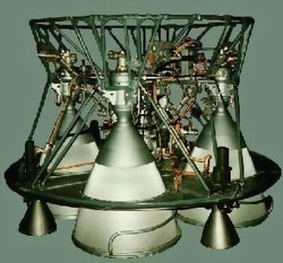
After moving through the Turbopump, the gases from the generator are recovered and used in four attitude control thrusters. Each of the thrusters provides 6 Kilonewtons of Thrust and can be gimbaled.
A reaction nozzle is mounted in the side of the stage and is used for collision avoidance maneuvers by venting the LOX Tank. Oxygen Tank pressurization is accomplished by evaporated and heated Oxygen while the RP-1 Tank is pressurized with combustion products from the Gas Generator.
RD-0110 has dry weight of 408 Kilograms. It is 1.58 meters in length and 2.24 meters in diameter. It operates at a chamber pressure of 68.2 bar. The third stage of the Soyuz burns for 300 seconds before deploying the Soyuz Spacecraft.
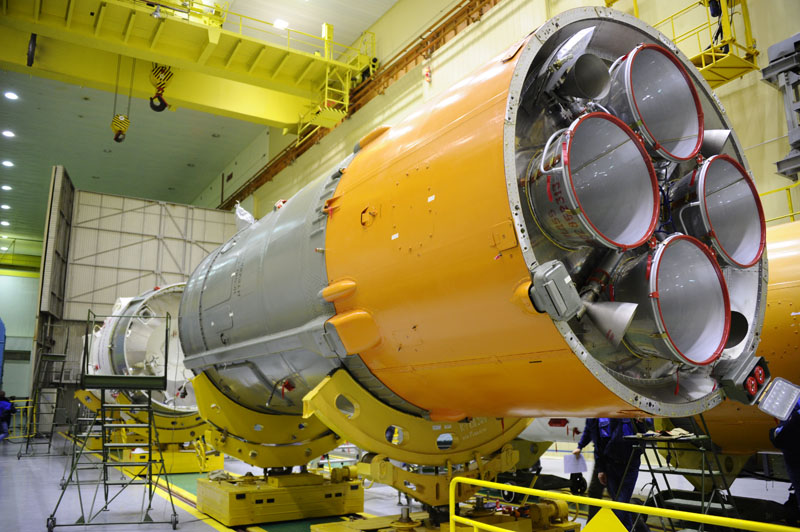
Fregat Upper Stage
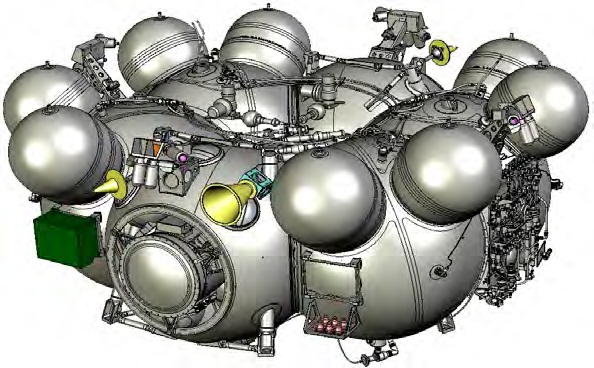
| Type | Fregat Upper Stage |
| Diameter | 3.35m (Fregat) to 3.38m (MT) |
| Length | 1.55m (Fregat) to 1.85m (MT) |
| # Propellant Tanks | 4 |
| # Avionics Tanks | 2 |
| Fuel | Unsymmetrical Dimethylhydrazine |
| Oxidizer | Nitrogen Tetroxide |
| Fregat | |
| Inert Mass | 930kg |
| Propellant Mass | 5,250kg |
| Launch Mass | 6,200kg |
| Fregat-M | |
| Inert Mass | 960kg |
| Propellant Mass | 5,750kg |
| Tanks | Small Tank Extensions |
| Launch Mass | 6,710kg |
| Fregat-MT | |
| Inert Mass | 1,050kg |
| Propellant Mass | 7,100kg |
| Tanks | Large Tank Extensions |
| Launch Mass | 8,150kg |
| All Fregat Stages | |
| Propulsion | S5.92 |
| Type | Turbopump-fed |
| Thrust at Level 1 | 19.85kN |
| Thrust at Level 2 | 14.00kN |
| Impulse | 331s |
| Dry Mass | 80kg |
| Engine Length | 1.03m |
| Engine Diameter | 0.84m |
| Chamber Pressure | 6.85 to 9.8 MPa |
| Startup Time | 2.5 to 3.0sec |
| Burn Time | Variable – Up to 900 sec |
| Restart Capability | Up to 20 Restarts |
| Attitude control | Main Engine Translation (Pitch, Yaw) |
| 8 Hydrazine Thrusters (Pitch, Yaw) | |
| 4 Hydrazine Thrusters (Roll) | |
| ACS Thrusters | S5.221 |
| ACS Thrust | 50N |
| ACS Propellant | 85kg |
| Separation | Gas pressure Locks/Pushers |
| Shutdown | Commanded/Depletion |
| Operation Lifetime | Up to 48 hours |
| Flight Computer | Biser 6 |
| Navigation | 3-axis Platform (Gyros, GPS) |
To increase Launch Vehicle performance and provide precise injection capabilities, the Soyuz FG can be outfitted with a Fregat Upper Stage that is capable of performing several burns to target a variety of different orbital trajectories.
Fregat is an autonomous Upper Stage that is equipped with its own power, propulsion and control system to perform flights of up to 48 hours. The upper stage consists of six spherical tanks (four for propellant, two for avionics) arrayed in a circle, with trusses passing through the tanks providing structural support. NPO Lavochkin of Moscow is responsible for the production of Fregat.
The conventional Fregat upper stage measures 3.35 meters in diameter and is 1.55 meters in length with six propellant tanks. Four tanks hold propellants, two are filled with Unsymmetrical Dimethylhydrazine and two contain Nitrogen tetroxide Oxidizer.
The other two ‘tanks’ are used to facilitate the avionics including the Biser-6 flight computer and the batteries. This allows for a simplified manufacturing process and provides a simple solution for environmentally controlling the systems.
Fregat is available in several configuration, Soyuz uses the conventional Fregat, the Fregat-M and the Fregat-MT.
In the Fregat-M version, the upper stage features propellant tank extensions. Two spherical extensions are welded to each of the four main propellant tanks – these extensions add 30kg in mass to the stage and hold up to 500kg of additional propellant. The MT version uses larger extension tanks that weigh 120 Kilograms and carry 1,850kg of additional hypergolic propellant.
These tank extensions have been developed to allow Fregat to carry more propellant while maintaining its normal mass characteristics for easy flight program development. Anther version, Fregat-SB, is used on the Zenit Rocket carrying an additional toroidal propellant tank.
Fregat uses heritage components to provide high reliability during its missions. The S5.92 Main Engine has been in use for more than 30 years and the Control System of the Vehicle features redundant components and has been used on a number of missiles and launch vehicles.
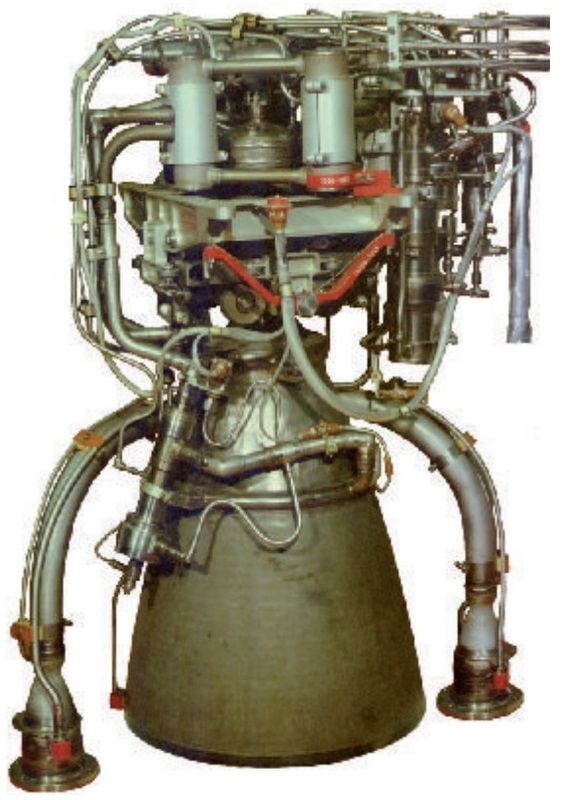
Fregat uses heritage components to provide high reliability during its missions. The S5.92 Main Engine has been in use for more than 30 years and the Control System of the Vehicle features redundant components and has been used on a number of missiles and launch vehicles.
The S5.92 main engine of the Fregat upper stage is a hyperbolic turbopump-fed main engine that uses a staged combustion cycle. A small amount of propellant is burned inside a gas generator that drives the turbine powering the turbopumps for the oxidizer and fuel. The exhaust is expelled via two nozzles. Propellants injected into the main combustion chamber are responsible for generating the majority of the thrust of the engine.
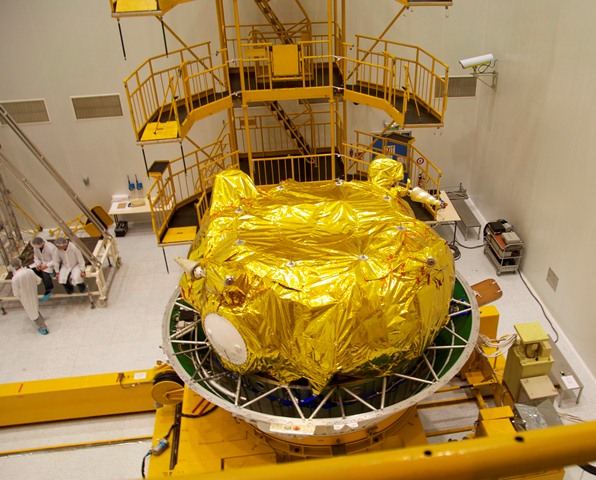
S5.92 can be operated at a full thrust level of 19.85 Kilonewtons and a reduced thrust level of 14kN, allowing it to fly a variety of mission profiles. The engine is 0.84 meters in diameter and 1.03 meter long, with an inert mass of 80 Kilograms. Depending on the thrust setting, the engine operates at a chamber pressure of 6.85 to 9.8 MPa and generates a specific impulse up to 331 seconds. It can be re-started up to 20 times.
The main engine can be gimbaled to provide pitch and yaw control during operation. For roll control during burns and three-axis control in coast phases, Fregat is equipped with 12 S5.221 attitude control thrusters. These thrusters use Hydrazine monopropellant stored in two tanks that are installed on Fregat, containing up to 85kg of propellant.
The thrusters are installed in four pods – each pods contains two pitch/yaw thrusters and one roll thruster, each delivering 50 Newtons of thrust. The thrusters are also used for propellant setting burns ahead of main engine firings.
Pressurization of the main propulsion system and the attitude control system is accomplished using high-pressure Helium that is stored in spherical tanks, each with a volume of 23 liters. The number of tanks depends on the version of Fregat that is used and the chosen flight profile. Fregat is also used for pneumatics – valve and engine actuation.
Fregat, Fregat-M & Fregat-MT

Payload Fairing
For the Soyuz-FG, there are two basic payload fairing sizes. One is used to launch the Progress Spacecraft while the other is used for flights with optional Upper Stages like Fregat.

